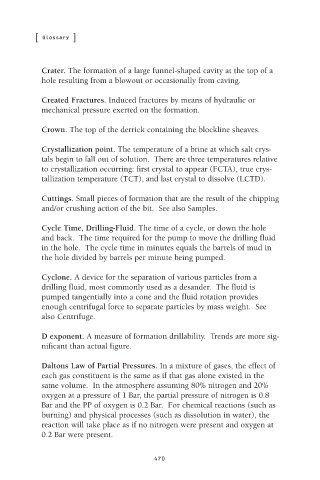Page 494 - Practical Well Planning and Drilling Manual
P. 494
Appendix NEW! revised 11/00/bc 1/30/01 3:30 PM Page 470
[ ]
Glossary
Crater. The formation of a large funnel-shaped cavity at the top of a
hole resulting from a blowout or occasionally from caving.
Created Fractures. Induced fractures by means of hydraulic or
mechanical pressure exerted on the formation.
Crown. The top of the derrick containing the blockline sheaves.
Crystallization point. The temperature of a brine at which salt crys-
tals begin to fall out of solution. There are three temperatures relative
to crystallization occurring: first crystal to appear (FCTA), true crys-
tallization temperature (TCT), and last crystal to dissolve (LCTD).
Cuttings. Small pieces of formation that are the result of the chipping
and/or crushing action of the bit. See also Samples.
Cycle Time, Drilling-Fluid. The time of a cycle, or down the hole
and back. The time required for the pump to move the drilling fluid
in the hole. The cycle time in minutes equals the barrels of mud in
the hole divided by barrels per minute being pumped.
Cyclone. A device for the separation of various particles from a
drilling fluid, most commonly used as a desander. The fluid is
pumped tangentially into a cone and the fluid rotation provides
enough centrifugal force to separate particles by mass weight. See
also Centrifuge.
D exponent. A measure of formation drillability. Trends are more sig-
nificant than actual figure.
Daltons Law of Partial Pressures. In a mixture of gases, the effect of
each gas constituent is the same as if that gas alone existed in the
same volume. In the atmosphere assuming 80% nitrogen and 20%
oxygen at a pressure of 1 Bar, the partial pressure of nitrogen is 0.8
Bar and the PP of oxygen is 0.2 Bar. For chemical reactions (such as
burning) and physical processes (such as dissolution in water), the
reaction will take place as if no nitrogen were present and oxygen at
0.2 Bar were present.
470

